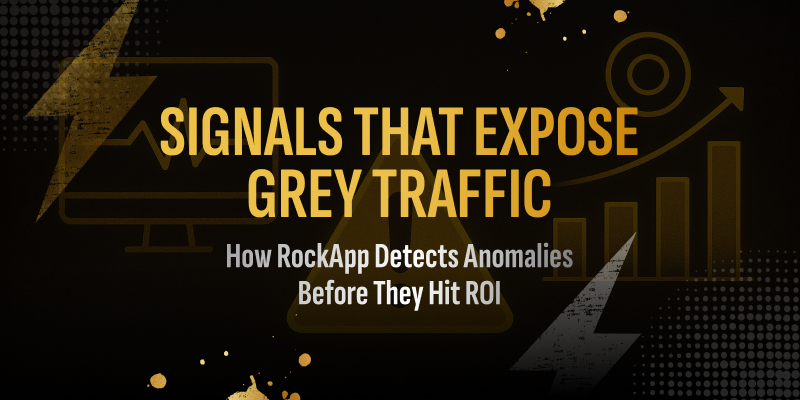In performance marketing, clarity defines profitability. Every signal, every conversion, every user path matters - especially when traffic volumes scale across regions and verticals. At RockApp, we’ve seen how grey traffic silently distorts performance, shifting attribution away from real conversions and inflating acquisition costs.
This article explores how grey traffic enters the funnel, what patterns reveal it, and how performance teams can protect clean sources. For a deeper look at fraudulent mechanisms and detection models, read our Comprehensive Research on Fraudulent Traffic in the iGaming Industry.
What Grey Traffic Really Is

Grey traffic imitates legitimate ad sources but hides manipulative routing. It often passes through open exchanges, unverified sub-sources, or recycled partner inventories. From the outside, metrics appear stable - installs are delivered, click-to-install ratios look healthy, and reports remain consistent. Inside the data, however, attribution drifts: conversions are claimed by proxy networks, and the real value of high-performing campaigns is diluted.
In our audits, we frequently detect grey traffic blending from resold SDK placements and outdated attribution chains. These sources operate on thin margins, prioritizing quantity over retention, which eventually erodes performance predictability.
The Economic Impact of Grey Traffic

Attribution Drift and Misallocation
When attribution skews toward manipulated sources, optimization engines recalibrate incorrectly. Budgets move toward lower-quality inventory, pushing true ROI down while maintaining the illusion of stability.
eCPM Compression and ROAS Decline
Grey traffic inflates impressions and shallow installs, reducing eCPM across clean partners. We observe up to a 20-30% compression in eCPM within blended datasets, depending on the vertical.
Cohort Distortion
Artificial installs and assisted conversions affect retention metrics. User quality becomes inconsistent, and algorithmic models lose confidence - creating volatility in bidding strategies and automated scaling.
Where Grey Traffic Comes From

-
Open Ad Exchanges: Large-scale supply with minimal verification.
-
Unfiltered Sub-Sources: Secondary partners reusing campaign IDs.
-
Overlapping Partner Inventory: Shared placements where attribution splits across multiple buyers.
-
Outdated Fraud Filters: Legacy systems that fail to adapt to evolving spoofing methods.
Each of these paths generates measurable footprints - micro-anomalies in click-to-install timing, retention variance, and CPM fluctuation.
Signals RockApp Tracks to Detect and Isolate Grey Traffic

Our internal systems track anomalies across all major acquisition layers:
-
Timing Conflicts: Deviations between click timestamps and install confirmation.
-
Volume Anomalies in Stable GEOs: Unexpected growth without media or creative changes.
-
eCPM Shifts Without Cause: Price fluctuations unlinked to bid or placement changes.
-
Retention Pattern Deviation: Early drops in activity for users from newly added sub-sources.
-
Attribution Density by Cohort: Unusual clustering of conversions within narrow timeframes.
These indicators form the base of our Fraud Signal Matrix - a layered scoring system that identifies risk segments before they impact ROI.
Strategic Response - The RockApp Approach

Our anti-fraud framework combines MMP data pairing, clean-source segmentation, and real-time scoring. By aligning raw install data with MMP attribution, we verify source integrity across every campaign.
This approach was refined through our long-term work in iGaming, where traffic volatility is highest. Insights from our ongoing iGaming Fraud Research shaped our detection logic and guided the development of custom rules for click-to-install intervals, IP cluster mapping, and SDK signature tracking.
As a result, we’ve reduced grey-traffic impact by up to 35% across monitored funnels, with measurable improvements in ROAS and retention stability.
How Performance Teams Can Build Protection

-
Integrate Layered Monitoring - combine MMP logs with raw postbacks for source verification.
-
Implement Source-Level Feedback Loops - real-time alerts to media buyers when anomalies spike.
-
Test Attribution Density by Cohort - monitor outlier clusters of installs or conversions.
-
Audit Partner Chains Regularly - identify reselling or sub-source reuse.
-
Educate Teams on Fraud Signals - awareness is still the first layer of defense.
When teams apply these layers consistently, the result is clean data, stable cohorts, and sustainable growth across campaigns.
Conclusion
Grey traffic doesn’t just affect numbers - it affects decisions. Performance marketing thrives on precision, and precision starts with verified sources.
At RockApp, we combine human expertise with proprietary monitoring systems to maintain clean pipelines and protect the accuracy of every report. That’s how we sustain performance for brands that demand reliability, scale, and transparency.










